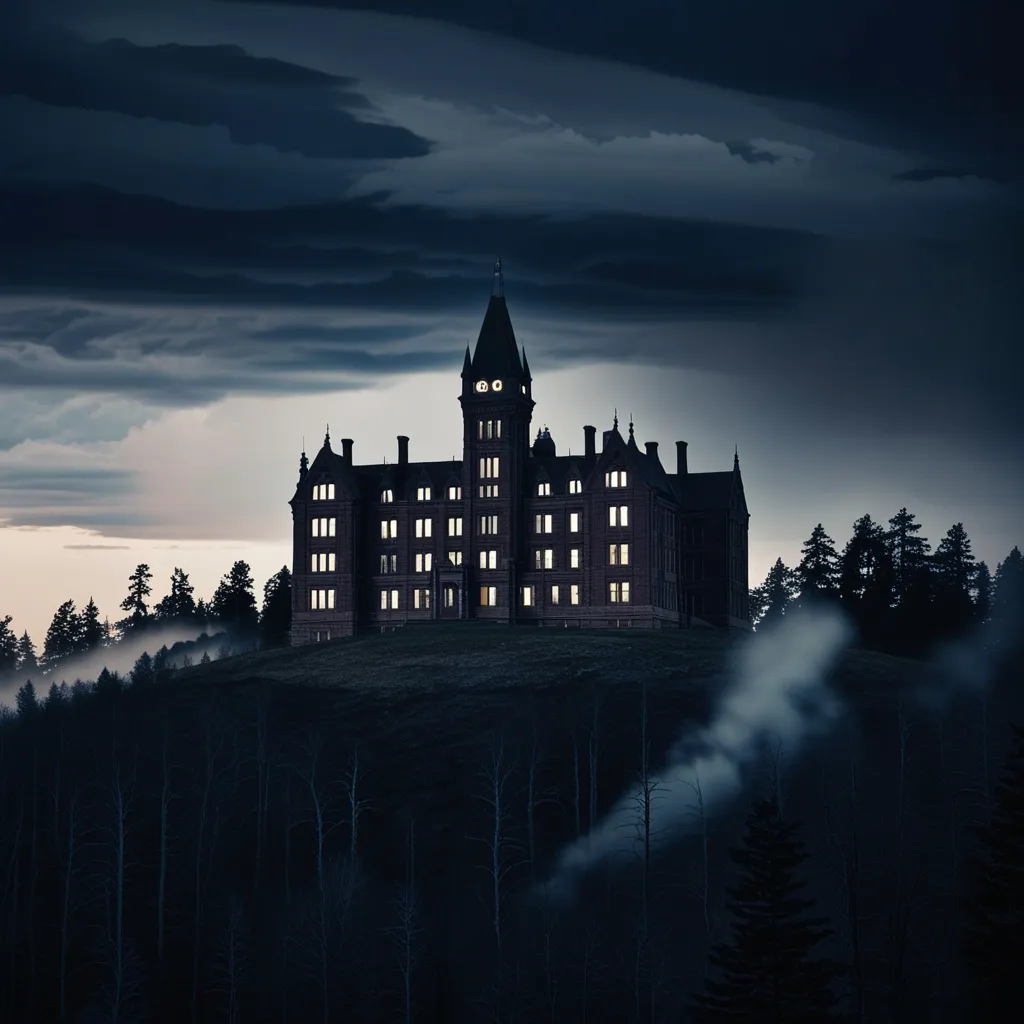Waverly Hills Sanatorium: A Haunting Legacy of Hope and Horror
Perched atop a windswept hill in Louisville, Kentucky, the Waverly Hills Sanatorium looms like a ghostly sentinel, its Gothic Revival architecture a stark reminder of a darker time in American history. This imposing structure, once a beacon of hope in the fight against tuberculosis, now stands as one of the most notorious haunted locations in the United States.
The story of Waverly Hills begins in the early 20th century, when tuberculosis was ravaging the nation. Known as the “white death,” this highly contagious disease was particularly brutal in Louisville, which had the highest tuberculosis death rate in the country by 1900. It was in response to this crisis that Waverly Hills was born.
Originally a modest two-story wooden building housing about 50 patients, Waverly Hills quickly grew to meet the ever-increasing demand. By 1926, it had transformed into a massive five-story hospital capable of housing 400 patients. The expansion was a testament to both the severity of the tuberculosis epidemic and the determination of those fighting against it.
But make no mistake, life at Waverly Hills was far from pleasant. The treatments offered, while considered cutting-edge at the time, were often brutal and ineffective. Patients were subjected to harsh weather conditions, believing that fresh air and sunlight could cure the disease. Some underwent surgeries to collapse their lungs, a desperate attempt to give the organ a chance to heal. Many spent years in isolation, cut off from family and friends.
One of the most chilling aspects of Waverly Hills is the infamous “death tunnel.” This 500-foot-long concrete passage ran from the first floor to the bottom of the hill, used to discreetly remove the bodies of those who didn’t survive. It’s estimated that over 50,000 patients lost their lives within these walls. The tunnel served a dual purpose, also bringing in supplies, making the facility nearly self-sufficient with its own post office, water treatment facility, and even a ZIP code.
The isolation at Waverly Hills wasn’t just physical. Families were torn apart as parents and children were admitted, often with little to no contact with their loved ones outside. This emotional toll, combined with the harsh treatments and high mortality rate, created an atmosphere of despair and suffering that many believe lingers to this day.
It’s no wonder, then, that Waverly Hills has become a hotspot for paranormal activity. Ghost hunters and curious visitors flock to the site, hoping to catch a glimpse of the spirits said to roam its halls. The stories of ghostly encounters are as varied as they are chilling.
One of the most famous spectral residents is a young boy named Timmy. Unlike the more somber ghosts, Timmy is known for his playful nature. Visitors report rolling balls down the long corridors, only to have them mysteriously rolled back. It’s as if Timmy is still there, seeking the childhood he was denied in life.
Then there’s the “man in white,” a mysterious figure seen drifting through the corridors late at night. Despite numerous sightings, his identity remains a mystery, adding to the intrigue that surrounds Waverly Hills.
Perhaps the most tragic ghost is that of a nurse who allegedly took her own life in the building. Her spirit is said to still wander the halls, a reminder of the toll the sanatorium took not just on patients, but on staff as well.
Personal encounters with the paranormal at Waverly Hills are countless. Visitors report unexplained phenomena like slamming doors, lights appearing in empty rooms, and objects moving on their own. One writer described a visit on a stormy night in 2002, where the only sounds were the creaks of the old building and the occasional drip of rain. Despite being experienced in exploring allegedly haunted locations, this visit left them convinced they had seen a ghost.
Professional paranormal investigators have also been drawn to Waverly Hills. Teams from popular TV shows have captured electronic voice phenomena (EVP) and video evidence of shadowy figures, further cementing the sanatorium’s reputation as one of America’s most haunted places.
In 1996, new owners purchased the property and began a restoration project to preserve the building and its history. Interestingly, volunteers working on the restoration reported numerous ghostly encounters of their own. From hearing phantom footsteps to seeing apparitions and even experiencing physical interactions with unseen forces, these reports only added to the building’s supernatural reputation.
Today, Waverly Hills Sanatorium is open to the public for both historical and paranormal tours. Visitors can explore the sprawling facility, including the infamous death tunnel, the morgue, and the rooms where patients once lay. The nonprofit organization responsible for the building’s maintenance ensures that the site is preserved for future generations, both as a historical landmark and a place of paranormal fascination.
But Waverly Hills is more than just a haunted building or a tourist attraction. It’s a powerful reminder of a dark chapter in our medical history. The stories of its ghosts, whether playful like Timmy or tragic like the nurse, serve as echoes of the human experience during one of the most challenging periods in healthcare.
For those brave enough to walk its halls, Waverly Hills offers a unique blend of history, mystery, and fear. It’s a place where the past and present intersect, where the living can glimpse the lingering presence of those who came before. Whether you’re a skeptic or a believer, a visit to Waverly Hills Sanatorium is an experience that will leave you with a lasting impression and a deeper understanding of the complexities of human existence.
The sanatorium stands as a testament to both the horrors of disease and the resilience of the human spirit. It reminds us of the progress we’ve made in medicine, while also serving as a cautionary tale about the unintended consequences of well-meaning treatments.
As you walk through the corridors of Waverly Hills, you can’t help but feel the weight of history. The walls seem to whisper stories of pain, hope, and loss. You might catch a glimpse of a shadow out of the corner of your eye or feel a sudden chill in an otherwise warm room. These experiences, whether explained or not, connect us to the thousands who lived and died within these walls.
The legacy of Waverly Hills extends beyond its ghostly reputation. It serves as a powerful reminder of the importance of medical research and the ongoing fight against infectious diseases. In an era where we face new global health challenges, the story of Waverly Hills resonates with a particular poignancy.
For those interested in the paranormal, Waverly Hills offers endless opportunities for investigation. From high-tech ghost hunting equipment to simple personal experiences, there’s no shortage of ways to explore the supernatural side of the sanatorium. But even for skeptics, the historical significance and atmospheric setting make it a fascinating place to visit.
As night falls and shadows lengthen across the grounds of Waverly Hills, it’s easy to imagine the lives that were lived and lost here. The sanatorium stands as a bridge between worlds - the world of the living and the world of memory and spirit. It challenges us to confront our fears, to consider the nature of life and death, and to reflect on the shared human experience that connects us all.
In the end, Waverly Hills Sanatorium is more than just a haunted building. It’s a place where science and mystery converge, where the spirits of the past continue to whisper their stories to those willing to listen. It’s a reminder of our shared history, a testament to human resilience in the face of suffering, and a window into the mysteries that continue to captivate our imagination.
Whether you believe in ghosts or not, a visit to Waverly Hills is sure to leave you with questions, reflections, and perhaps a new perspective on the thin line between this world and the next. As you leave the grounds, you might find yourself looking back, wondering if you too have become part of the ongoing story of this remarkable place. And who knows? Maybe, just maybe, you’ll catch a glimpse of Timmy’s ball rolling down a distant corridor, a playful reminder that at Waverly Hills, the past is never truly gone.






